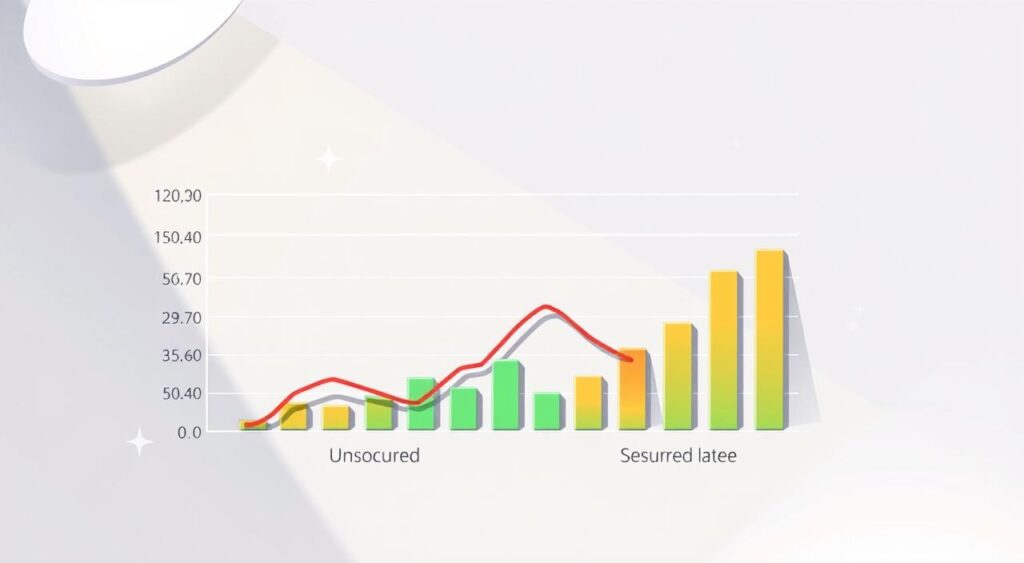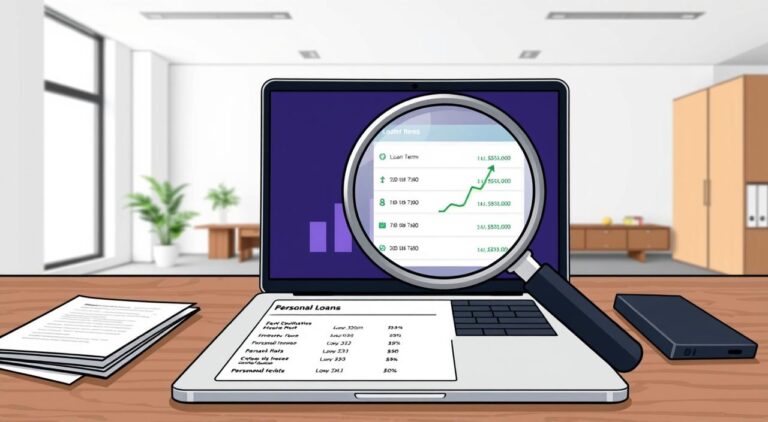Unsecured vs Secured Line of Credit: Key Differences
When it comes to borrowing, understanding the nuances between secured and unsecured lines of credit is crucial. The primary distinction lies in the requirement of collateral, which significantly impacts approval odds and interest rates.
A line of credit provides borrowers with flexible access to funds, but the presence or absence of collateral affects the lender’s risk and, consequently, the terms of the credit.
By exploring the advantages and disadvantages of each option, borrowers can make informed decisions tailored to their financial situations.
Key Takeaways
- Understand the fundamental differences between secured and unsecured lines of credit.
- Learn how collateral impacts approval odds and interest rates.
- Discover the advantages and disadvantages of each type of credit line.
- Evaluate your financial needs and risk tolerance to choose the most suitable option.
- Understand the qualification requirements and approval process for both secured and unsecured credit options.
Understanding Lines of Credit
Understanding the basics of a line of credit is crucial for making informed financial decisions. A line of credit is a flexible loan from a financial institution that consists of a defined amount of money that you can access as needed and repay immediately or over time.
What Is a Line of Credit?
A line of credit functions as a flexible borrowing arrangement where consumers can access funds up to a predetermined limit, similar to a credit card but often with different terms and uses. This financial product allows borrowers to draw only what they need when they need it, potentially saving on interest costs by borrowing only necessary amounts.
https://www.youtube.com/watch?v=3nTFI-kroB8
How Lines of Credit Work
Lines of credit typically require monthly minimum payments based on the amount borrowed, with interest accruing only on the funds you’ve actually used rather than the entire credit limit. The revolving nature of lines of credit means that as you repay the borrowed amount, your available credit replenishes, allowing you to borrow again without reapplying. This makes lines of credit a versatile tool for managing debt and financing various needs.
Secured Lines of Credit Explained
A secured line of credit is a type of loan that requires collateral to secure the borrowed amount. This means that borrowers must pledge specific assets to guarantee repayment.
Definition and How They Work
A secured line of credit involves a lender placing a lien on the borrower’s collateral, which can be a home, vehicle, or savings account. The lender can claim this collateral if the borrower defaults on their payments.
Common Types of Collateral
Common types of collateral include real estate, vehicles, cash deposits, and investment accounts. The type and value of the collateral directly influence the credit limit offered by the lender.
Examples of Secured Credit Options
Popular secured credit options include Home Equity Lines of Credit (HELOCs), which allow homeowners to borrow against their home’s equity, and secured credit cards, which require a cash deposit that equals the credit limit. Business lines of credit may also be secured by company assets, such as inventory or equipment.
By understanding the different types of secured lines of credit and their requirements, borrowers can make informed decisions about their financial options.
Unsecured Lines of Credit Explained
For individuals seeking financial flexibility without risking assets, unsecured lines of credit are a viable option. Unsecured lines of credit offer a financial safety net without requiring collateral, making them an attractive choice for many borrowers.
Definition and How They Work
Unsecured lines of credit are financial products that allow borrowers to access funds without pledging collateral. Instead, lenders assess the borrower’s creditworthiness, income stability, and overall debt-to-income ratio to determine approval and credit limits.
Qualification Requirements
To qualify for an unsecured line of credit, borrowers typically need to demonstrate a good credit history and stable income. Lenders closely examine credit scores, payment history, and existing debt obligations before extending credit.

Examples of Unsecured Credit Options
Common examples of unsecured credit include traditional credit cards, personal lines of credit, and overdraft protection on checking accounts. These options provide flexible access to funds without securing specific assets, reflecting the lender’s reliance on the borrower’s financial health rather than collateral.
It’s worth noting that while unsecured lines of credit may offer less risk in terms of asset loss, they often come with higher interest rates compared to secured credit options. Borrowers should carefully consider their financial situation and credit score before applying.
Unsecured vs Secured Line of Credit: Key Differences
The choice between a secured and unsecured line of credit depends on several key factors that borrowers must carefully consider. These factors include collateral requirements, interest rates, approval processes, credit score requirements, and risk factors.
Collateral Requirements
The fundamental difference between secured and unsecured lines of credit lies in collateral requirements. Secured lines demand assets as security, while unsecured lines rely on the borrower’s promise to repay. This distinction significantly impacts the terms and conditions of the credit.
Interest Rates Comparison
Interest rates vary significantly between secured and unsecured lines of credit. Secured loans typically offer lower interest rates because they pose less risk to lenders. The difference can be as much as 2-5 percentage points compared to unsecured options.

Approval Process and Criteria
The approval process differs substantially between the two. Secured lines focus on both creditworthiness and collateral value, while unsecured approvals hinge on credit history, income stability, and debt obligations.
Credit Score Requirements
Credit score requirements also vary. Secured lines may be accessible with fair credit scores (620-660), while unsecured options typically require good to excellent scores (670+) for competitive rates.
Risk Factors for Borrowers
The risk allocation shifts dramatically between options. Secured lines pose greater risk to borrowers due to potential asset loss, while unsecured lines protect borrowers’ assets but present higher risk to lenders.
In conclusion, understanding these key differences is essential for choosing the right line of credit that aligns with your financial situation and borrowing needs.
Advantages and Disadvantages
Secured and unsecured lines of credit have distinct advantages and disadvantages that can significantly impact a borrower’s financial situation. Understanding these differences is crucial for making an informed decision that aligns with one’s financial priorities and risk tolerance.
Pros and Cons of Secured Lines of Credit
Secured lines of credit offer several benefits, including lower interest rates and higher borrowing limits, making them attractive for large financial needs. The collateral provided reduces the risk for lenders, often resulting in more favorable terms. However, the primary disadvantage is the risk of losing collateral if payments are missed. Additionally, the process may involve extra costs for collateral appraisal and verification, potentially prolonging the approval process.
Pros and Cons of Unsecured Lines of Credit
Unsecured lines of credit provide significant advantages, such as not risking personal assets and typically having faster approval processes. They are beneficial for borrowers who need quick access to funds without wanting to pledge collateral. However, they usually come with higher interest rates and stricter eligibility criteria, making them more challenging to obtain for those with less-than-perfect credit. Moreover, the borrowing limits may be lower compared to secured options.
How to Choose Between Secured and Unsecured Credit
To make an informed decision between secured and unsecured credit, you need to assess your financial situation and borrowing needs. This involves considering several factors, including your credit score, existing debt obligations, and available assets.
Assessing Your Financial Situation
Begin by evaluating your current financial situation, including your credit score, existing debt obligations, and income stability. You should also consider your available assets that could potentially serve as collateral for a secured loan.
Determining Your Borrowing Needs
Carefully evaluate your borrowing purpose and timeline. If you have short-term needs with a definite repayment plan, unsecured options might be more suitable. However, if you’re financing a major purchase or investment, a secured credit option with a lower interest rate might be more beneficial.
Evaluating Your Risk Tolerance
Consider your risk tolerance honestly. Secured credit puts specific assets at risk but offers better terms, while unsecured credit protects your assets but comes with higher costs and stricter qualification requirements. For more information on managing risk, you can visit financial resources that provide guidance on making informed decisions.
- Assess your credit profile objectively to determine the best credit option for your needs.
- Evaluate your asset portfolio to unlock higher borrowing power at favorable rates.
- Consider consulting with financial advisors for personalized guidance.
Conclusion
Understanding the differences between secured and unsecured lines of credit is essential for making an informed decision that aligns with your financial needs. Both options serve valuable purposes, with the optimal choice depending on your specific financial circumstances, goals, and risk tolerance.
Secured lines of credit offer lower interest rates and higher borrowing limits, making them suitable for major expenses or debt consolidation. In contrast, unsecured lines of credit provide financial flexibility without risking assets, ideal for those with strong credit profiles.
Ultimately, responsible credit management is crucial for maintaining financial health, regardless of the chosen credit type.






